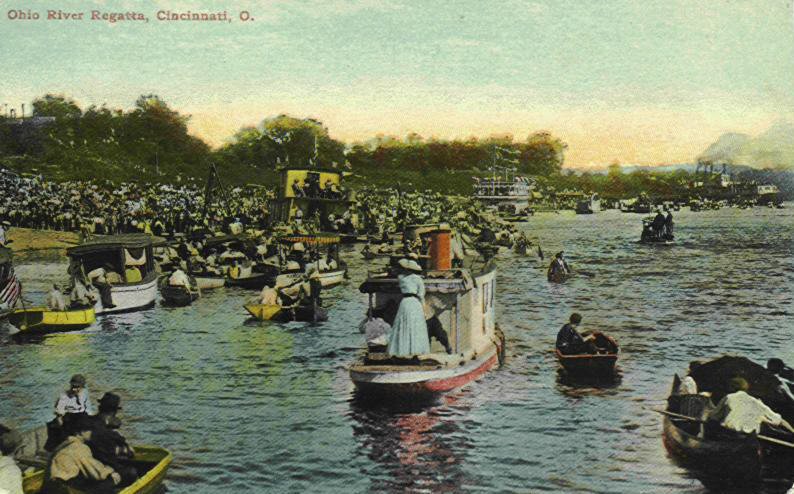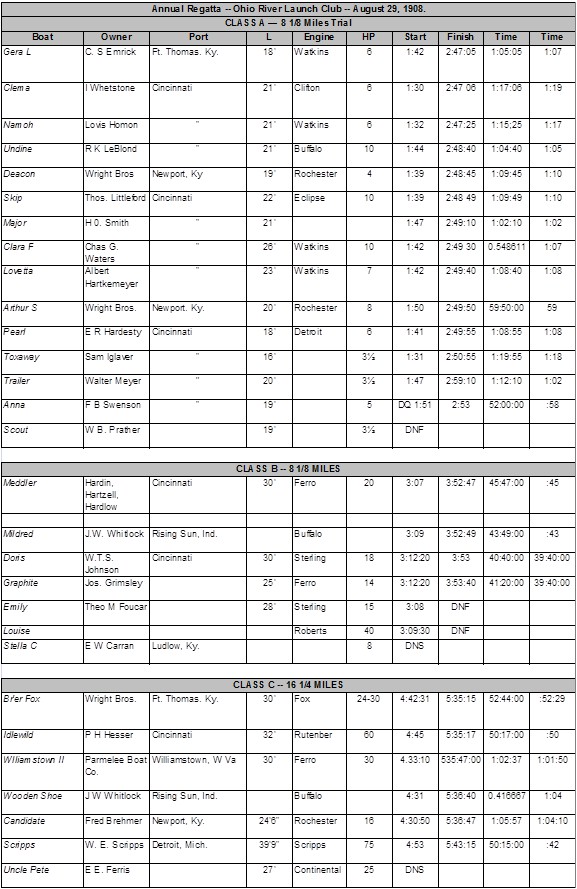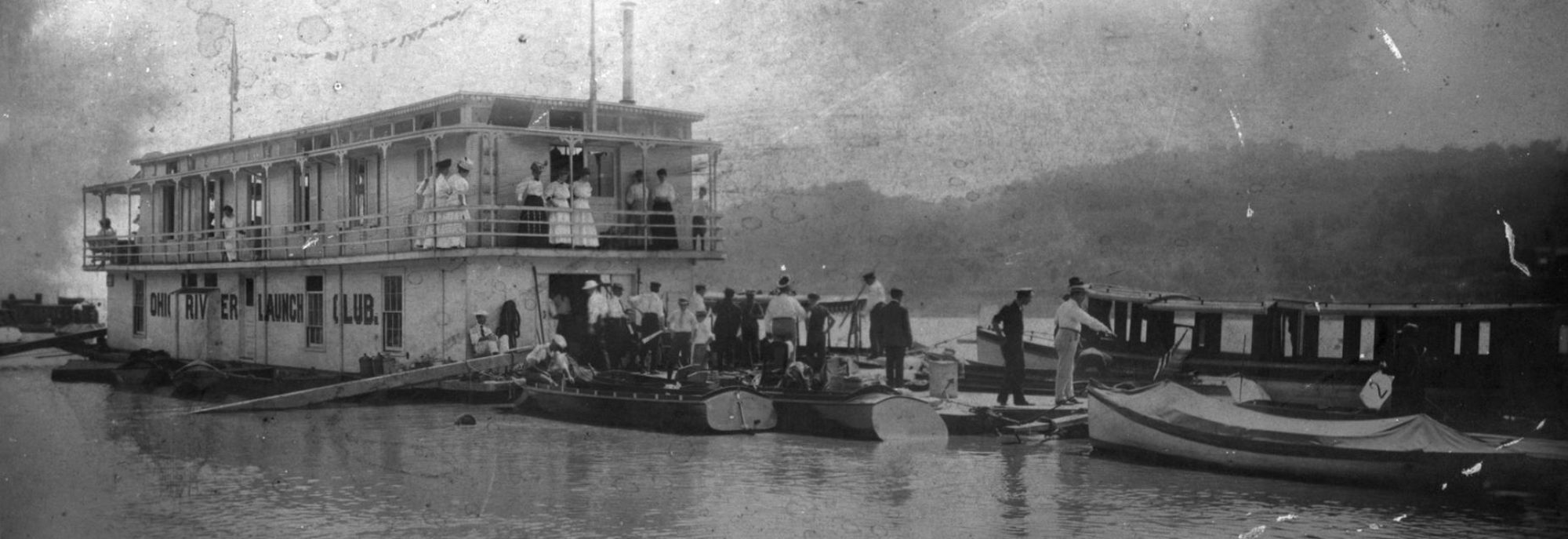1908 Ohio River Launch Club Regatta
Race Day on the Ohio
Being a more or less lucid account of the annual regatta of the Ohio River Launch Club of Cincinnati as witnessed and illustrated by the “man on the job”
Cincinnati, unlike Detroit, boasts not that it holds within its earthen bowl all for which life is worth living. it needs no advertising. The visitor drops in from the hills to the north and is swallowed up by the hospitality of its citizens. They lure him across the Rhine, they entice him to Coney, or, if he be a boat lover, they take him a long trip out Eastern avenue, and they keep him until he runs away. When he must go, their Godspeed invariably carries a postscript, “We hope you miss your train, and if you do–come back.”

That’s Cincinnati, the home of the Ohio River Launch Club. Only a hundred strong, to be sure, but a mighty healthy, hospitable hundred, as full of enthusiasm and play as a bunch of kids. If they carry sober, serious faces into their business pursuits, they leave them behind them when they go to the river front. The celebrated Taft smile is no longer a mysterious bit of personality in the great campaigner; it’s common as clay in his home town. His old neighbors are just as big and round and jolly–we venture to say that Boss Cox owes his political strength to just that splendid, straightforward personality, which will put Sec’y Taft at the head of the nation this fall.
But Cox and Taft are only types, our story has to do with real live launch men, boat owners, captains, engineers, and plain deckhands. They don’t wear much gold braid or white duck at the O.R.L.C. There is only one Commodore and he isn’t overloaded with medals; not that he doesn’t deserve them, but he has no competition. Compared with the average yachting center, Cincinnati is like a virgin forest when it comes to gold lace and rocking chair sailors. it was refreshing, to say the least, to meet these plain, unassuming men and taste their pure, unadulterated brand of sportsmanship. If they know the complicated game of beating the other fellow before he starts, they didn’t exhibit that knowledge on the occasion of our visit. From all appearances, the races were won or lost on the course.
The Ohio River Launch Club, as you may have already assumed, is one of the younger powerboat organizations of this country. it came into existence naturally on account of the growing popularity of the gasoline launch along the great inland waterway whose name it bears. On the stretches of the river above the city where its quarters are located, the opportunities for pleasure boating are surprisingly good. The stream is muddy and the channel is none too deep, but it winds in and out between magnificent hills presenting an ever-changing scene of bewildering beauty. Perhaps in the necessity for careful navigating and the absolute lack of ordinary seagoing dangers and discomfort, lies the charm of owning and using a boat on the Ohio.
We sat on the club veranda and watched a continuous procession of small launches and power houseboats leaving the city Sunday morning bound up river for a day’s outing. Invariably they were family parties, men, women and children, lunch baskets and beer–always beer. Every boat had her tonnage quota of passengers and then some. But they puttered along with gunwales almost awash, intent upon the pleasures of being afloat and knowing they were sure of smooth water and a fair tide for the homeward trip. On our large bodies of water about two-thirds of this fleet would be reported missing before nightfall. If they didn’t open up and sink outright, the first bit of sea would swamp them.
It is under these conditions that the Ohio River L.C. has flourished until it is worthy of more than ordinary notice in the power boat world. The club took up racing last year and held its first annual regatta. it was a success. Having been identified with shell and canoe racing for many years, the boating population discovered great possibilities for sport in the launch contests. They used the A.P.B.A. method of rating and handicapping the boats, but the theory of contestants and midship sections didn’t fit into their practical way of doing things. This year they sought a common sense rule and they found it in the actual performance plan.
The 1908 regatta was held on Saturday afternoon, Aug. 29. Three classes were called for in the schedule–Class A–open boats 15 to 25 feet long with engines not exceeding 10 horsepower. Class B–open boats of semi-speed type, making a speed of 10 to 15 miles an hour. Class C–launches of so-called automobile type, making a speed of 15 miles an hour or better.
Classes A and B started in front of the club house and ran up the river to a stakeboat opposite Coney Island and return, a distance of 8½ miles. Class C covered the same course but made the trip twice, 16¼ miles. All the entries ran the course before the race and handed in their time from which the handicaps were figured. Three per cent excess of the trial time was allowed in the race without disqualification. The boats were started on their handicaps so that the first boat to finish within the 3 per cent limit was the winner.
The dope was all right. Dr. Berhausen, chairman of the race committee, assisted by Messrs. Carlisle, Hafner, Witt and Handman, carefully oiled the starting mechanism and there was not a hitch in the preparations. When we blew in Saturday morning they were working hard, so we had time to look over the premises.
The clubhouse is a two story houseboat perhaps 80 feet long and 30 feet wide. On the lower floor is a reception room, lockers for the members and a dunnage room at the rear gangway. The scow extends forward and aft several feet beyond the house, affording landing stages at either end. A stairway leads from the reception room to the second floor. Except for a kitchen and serving room at the rear end the upper deck is one big room. Small tables are set for meals and at other times the floor is cleared for meetings, smokers and dancing. At the forward end is a covered veranda of good size. Along the sides is a narrow railed passageway.
The house is moored to the shore with huge cables reaching up over the 50-foot bank. At the time we write the water in the river was very low, averaging hardly six feet depth in the channel. During flood time it sweeps down the valley over the high banks in a muddy torrent a mile wide and 60 feet deep. On account of the continual rise and fall of the river level during the boating season, everything about the clubhouse is strongly moored. The floats and approaches remind one very much of salt water with the tide always setting one way.
The boats began to arrive before noontime. Of the big fleet expected from Marietta and the up river towns only one could get over the sand bars. That was Williamstown II, owned by the Parmelee Boat Co. of Williamstown, W. Va. It had taken her almost four days to come 300 miles. J. W. Whitlock* of Rising Sun, Ind., brought up two boats, Mildred, a fast runabout, and Wooden Shoe, in the auto boat class. Newport and Fort Thomas across the river on the Kentucky side sent several starters. The most notable visitor, however, was Vice-Commodore W. E. Scripps, of the Detroit M.B.C., with his great lakes champion, Scripps. He was enthusiastically received and made an honorary member of the club before his departure.
At 1:30 Mr. Whetstone’s 21-footer Clema, the limit boat in Class A, was sent away. Toxaway, a midget 16-footer, followed her a minute later and then they came in singles and in pairs–15 in all–until 1:51, when the scratch boat Anna, a speedy 19-footer owned by F. B. Swenson of Cincinnati, was given her gun. According to the rated times, the bunch were due back at 2:49, but Anna was a sport. She got home at 2:43 to the great joy of the multitude and the disgust of the judges, who immediately put her on ice to cool off and mediate upon the error of her evil ways.
Shortly behind Anna came Clema and Gera L., the former with her clutch thrown out and the latter squirming and twisting from one side to the other to prevent crossing the line too soon. The crowd was urging them on while they were equally insistent that the finish line was no good place until the penalty time expired. It was ludicrous for one who knew the game to watch the antics of these contestants. Finally Gera squared away right under the judges’ boat and crossed the line one second ahead of Clema. Gera took the Pickering trophy, and Clema the Homan Cup on a performance of better than 102 per cent. Namoh finished at full speed 19 seconds behind Clema, followed by the next three boats, Undine, Deacon and Skip, within a minute. Of 15 starters seven beat their rated time–it was some going; and some figuring. Six more finished between 2:49:10 and 2:50:55. One boat, Scout, failed to show up.
At 3 o’clock Class B came out of the paddock. By this time the river was packed with boats and the hills banked with people. We have seen several big regattas all over the country in this and other years, but in point of attendance, when you count hulls and noses we have never seen anything to equal that day at Cincinnati. An estimate of 300 boats and 10,000 spectators afloat and ashore is no exaggeration. Where they came from and why they were there is almost an unanswerable question. No man ever conceived such a conglomeration of things that float. Everything from an excursion steamer to a catamaran made of soap boxes could be seen in the space of a mile. Canoes and river skiffs were like blades of grass in a forest of launches, stern wheel kickers and houseboats. The only salvation for the racing men was the fact that the current strung them down stream in more or less orderly lines and compelled everyone to anchor or hand on to the fellow ahead. You may believe it was indeed a sight and a sermon as well. If Cincinnati isn’t a real big noise in power boat circles before another season goes by we are no judge of circumstances.
In spite of the crowd and partly because of it, the game went merrily to a finish. Meddler led off Class B at 3:07, fol- lowed by Emily at 3:08, Mildred at 3:09, and Louise at 3:09:30. Graphite and Doris brought up the rear at 3:12:20. All of these boats were likely looking craft averaging between 25 and 30 feet with engines from 14 to 40 horsepower. The starts were spirited since Mr. Theo. Foucar had put up a handsome cup for the boat in Classes B and C that, in the opinion of the judges, made the best showing in getting across the line. It was won by J. W. Whitlock with his Class C racer, Wooden Shoe.
Meddler, of Cincinnati, was first boat home at 3:52:49, having taken 45:47 to make the course. She was a few seconds behind her rating And the peters Arms Co. trophy rewarded the efforts of her happy owners. Mildred, of Rising Sun, crossed the line two seconds behind the winner and her prize was the A. T. Hazen cup. Doris finished third, Graphite fourth, and the others failed to report.
A long, tiresome wait followed the finish of Class B and it was 4:30 when the speed boats were called. This was a mistake on the part of the committee who were trying to dodge the river steamers; that great enthusiastic band of rooters should not have been compelled to swing their heels and growl for something to happen. Some little discomfort to the racing men would have been far better than this discouraging display.
The limit boat in Class C was Candidate, a 25-footer from Newport, Ky. Her power was a 16 horse Rochester and her speed about 15 miles an hour. Ten seconds behind her came Wooden Shoe, a Buffalo outfit owned by Whitlock of Rising Sun. Williamstown II, 30-footer with 34 horse six cylinder Ferro came next at 4:33:10. These boats were out of sight on their way to Coney Island when Br’er Fox, Wright Bros.’ 30-footer, started at 4:21:31.
Paul Hesser sent Idlewild on a long stern chase at 4:45. She is undoubtedly the fastest boat in that section of the country. her length is 32 feet and beam 4 feet 10 inches. The power plant is an 8 cylinder 5×6 Rutenber engine, turning 22×36 Bryant & Berry wheel 1,000 revolutions per minute. She appeared down by the head too much for very high speed. Scripps was scratch boat at 4:53 and she was all of two minutes late in crossing the line. Even then she wasn’t up to speed as she seemed to labor hard in the shallow water. hardly had she passed out of sight when the leaders were seen coming down to the finish of their first lap. They were fairly well bunched with the limit boats ahead. Idlewild had the race won at this point and was far ahead of her time. Scripps, on the other hand, took 31 minutes for the first lap and was plainly out of the contest. He had burned up a plug half way to Coney, and in trying to put in a new one while running on five cylinders, the threads stripped and the new plug blew out, leaving him crippled for a short time.
The second lap brought trouble to Idlewild and gave Bre’r Fox a chance to get the lead on the home stretch. Hesser got to going again but could not catch the Newport flyer. Only two seconds separated the leaders at the finish. Williamstown II finished third, half a minute behind Idlewild. Wooden Shoe was a minute behind Williamstown with Candidate right in her wake. Scripps ran the second lap of 8 1/8 miles in 19 minutes, beating Idlewild for the time prize by a narrow margin.
As a result of her victory Bre’r Fox was awarded the Roll-Crawford-Brendamour cup. She is a particularly clean lined boat measuring 30 by 4 and is a credit to her builders. During the race her little six-cylinder 4½x4 Fox motor turned a 20×32 wheel about 900 revolutions per minute. The hull is capable of much higher speed as she hardly left a ripple at 18 miles. The power plant was only installed two days before the regatta, but its performance was splendid. Idlewild secured the Spaeth-Brophy cup put up for second prize, and Wooden Shoe the handsome Foucar cup for the best start. Scripps earned a silk pennant for making the fastest time.
There was nothing but feasting and pleasure for the wind up in the evening. No one lynched the committee and all hands seemed satisfied. They were glad to be aboard, and in foaming steins drank to the health of the Ohio River Launch Club and to each individual member until the spigots ran dry. Prosit.

(Transcribed from MotorBoat, Sep. 10, 1908, p. 38 by Greg Calkins and Leslie Field, Hyrdoplane History Website)
From “Hyrdoplane History Website”, http://www.lesliefield.com
